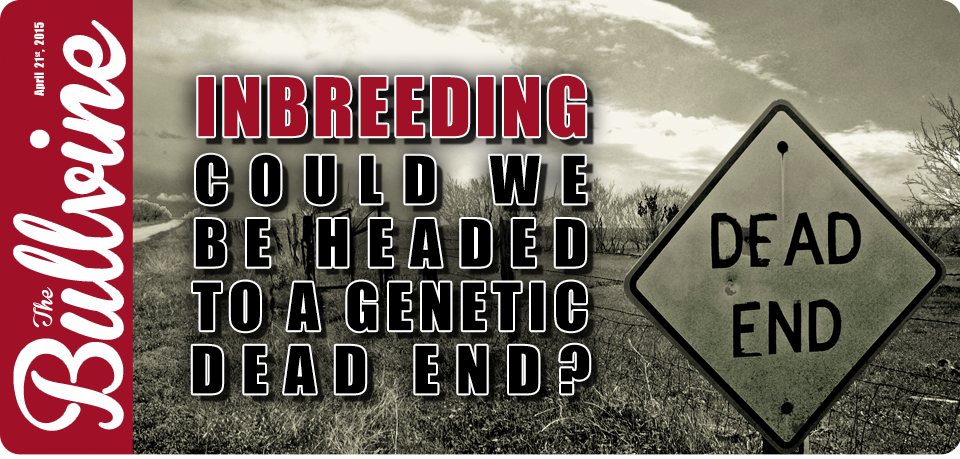Inbreeding and the lack of genetic diversity are on the radar screen of milk producers, breeding stock suppliers, A.I. companies and scientists. In some cases, they are barely there while for others it is a major concern. Every year there is new evidence that points to the fact that these factors should not be ignored when it comes to breeding decisions.
A New Approach to Studying Diversity
A recently published article by Yue, Dechow, and Liu, where they studied the limited number of Y chromosome lineages in North American Holsteins, gives discerning breeders serious food for thought. The results of this study appear in this month’s (April 2015) Journal of Dairy Science and is entitled “A limited numbers of Y chromosome lineages is present in North American Holsteins”.
Some Eye-Opening Facts
The researchers found that all current North American Holstein A.I. bulls trace to two sires from the 1880’s, Hulleman, and Neptune H. And that’s just the beginning of the narrowing of the bloodlines! The more in-depth study shows that, of three prominent sires from the 1960’s, Chief, Elevation, and Ivanhoe Star, two remain dominant today. The study reports that, in 2010, Pawnee Farm Arlinda Chief (48.8%) and Round Oak Rap Apple Elevation (51.0%) totally dominate, being present in 99.8% of all North American A.I. bull pedigrees. The data for this study came from Interbull’s files that contained 220,872 bulls worldwide born between 1950 and 2013. Of those bulls, 62,897 were from North America.
Genetic Diversity is No Longer
To say the least, we have severely narrowed the genetic diversity in North American Holsteins. Yue, Dechow and Liu state the obvious “We believe that the extreme lack of genetic diversity of Y chromosome could be a limiting factor toward improvement in Holsteins for male fertility traits that are influenced by the Y chromosome”.
The effects of reduced genetic diversity on male fertility is often not a high priority for breeders. Breeders think of calf liveability and growth, female reproduction, disease resistance, lifetime production and many more traits when it comes to the negative effects that result from inbreeding. The truth is that limiting our effective breeding population to two sires from the 1880’s and two of their descendants from the 1960’s is alarming.
Is this a Ticking Time Bomb?
Most of us ignore the actual situation. We accept, as a fact of life, that the rate of inbreeding in our dairy cattle is increasing every year. Could it be just a matter of time until we are doomed? Do breeds and breeding companies need to take the blinders off?
Finding Solutions
Dairy cattle breeders are usually quite creative when it comes to finding solutions. It means thinking outside the box. So let’s think outside that box!
Sourcing Sires: Now that we have DNA analysis in most countries with significant Holstein populations, it should be possible to find breed improving sires that do not contain Chief and/or Elevation in their pedigrees. Getting the genetics of such outcross sires incorporated into North America Holsteins is now simple enough. Simply IVF top North American Holstein cows and use those non-Chief and non-Elevation sires to produce sons. Then DNA test those sons and identify which ones have the different Y chromosome. The project will need to be large, but amongst the sons without Chief or Elevation Y chromosomes, there will be sires that are high based on genomic testing.
Lower Purity Requirements: North American Holstein breeders have prided themselves on having animals that are 100% pure as to breed. That’s nice but do we need to demand 100% purity at the expense of losing the breed because of lack of genetic diversity? In New Zealand the Kiwi breed, Holstein x Jersey, has been developed and it has gained wide acceptance by milk producers as the animals they want to work with on their pasture-based milk solids per hectare dairy farms. Bringing in genetic diversity from other breeds could produce a strain of Holsteins that suits the needs of bottom line focused dairy farmers everywhere.
Genetic Engineering: I understand that anything to do with altering nature is a controversial topic. However can we not learn from the success of crop breeders where they introduced new and constructive genes into plants? Introducing those new genes has been a major success story in positioning farmers everywhere to produce crops that have fed and will continue to feed our ever growing global population. Genetic engineering is a topic that ne eds serious consideration in dairy breeding.
These three suggested ways of finding a solution only scratch the surface of what’s available to an open-minded, progressive dairy cattle improvement industry
The Bullvine Bottom Line
North American Holstein breeders have been very successful in eliminating unproductive animals. As a result, the average production per cow has doubled in less than fifty years. But with that increased yield has come inbreeding, poorer reproduction, disease resistance challenges and other detrimental factors. Continuing to ignore the facts and refusing to search for ways to increase genetic diversity could take us down a road that leads to a dead end.
Get original “Bullvine” content sent straight to your email inbox for free.


















Leave a Reply
You must be logged in to post a comment.